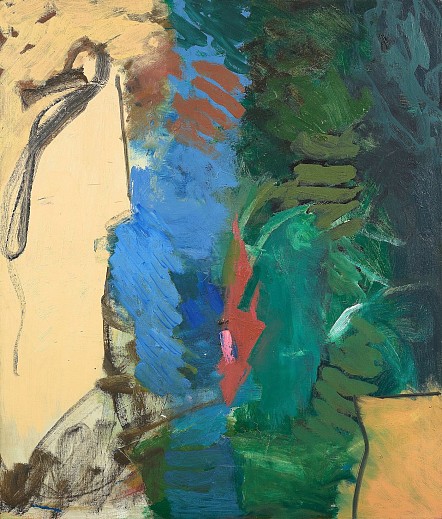
Woman's Art Journal | Yvonne Thomas: The Singleness of the Poetry
May 23, 2020 - Vittorio Colaizzi for Woman's Art Journal
Writing in 1981 of paintings made between 1955 and 1962, critic Theodore F. Wolff claimed that the work of Abstract Expressionist painter Yvonne Thomas (1913–2009) “reminds us that good painting is good painting regardless of the form it takes.”1 Wolff’s assertion must make the sober and disinterested scholar a little queasy, but it is typical, if somewhat strident, of criticism of Thomas’s work, in that it combines an appeal to quality with an acknowledgement of historical contingency. In this way it demonstrates the problem that Thomas’s work poses for educated viewers. Criticism of the last half century has tended to homogenize and dismiss gestural abstraction as an embodiment of inadvisably idealistic values, and as a foil to or baseline for the performative, sculptural, or photographic work that repudiated or grew from this kind of painting—consider for example the work of Carolee Schneemann (1939–2019). While painting itself currently enjoys wide and varied manifestations, and claims about Thomas’s sheer quality proliferate, a certain familiar aspect to her abstraction, as is evident in Summer Fantasy (1954; Pl. 1), was noticed in published criticism as early as 1956. This did not prevent Dore Ashton from attributing to her “genuinely fresh insights,” nor Donald Judd from excepting her from his nearuniversal condemnation of gestural abstraction with a positive review in 1960. 2
Born Yvonne Navello in Nice, France, in 1913, she moved to Boston with her family in 1926. She showed an interest and aptitude for art from an early age, and following studies at the Cooper Union began a career in commercial art in the 1930s. She married Leonard Thomas in 1938 (they lived in Newport, Rhode Island, during the war), and maintained close ties with the New York art world throughout her life (Fig. 1). She attended the Art Students League in 1940, and studied with Vaclav Vytacil. She also had private lessons with Dimitri Romanovsky (a Russian artist specializing in nudes and portraiture), and attended the Ozenfant School of Art. Nearly every published account of Thomas’s work mentions her participation in the innovative and short-lived painting workshop entitled “The Subjects of the Artists,” which ran from 1948 to 1949 and was initiated but abandoned by Clyfford Still and taken up by Mark Rothko, Robert Motherwell, William Baziotes, and David Hare. Barnett Newman joined in the second year. These sessions were an avenue for the five burgeoning Abstract Expressionists to share with an equal number of interested students, Thomas among them, their incipient methods of free painting, bidden by one’s inclinations in the face of the materials and presumably conditioned by the subconscious mind. Ten years later and throughout her life, this sense of freedom remained in her paintings and works on paper, as a small but expansive gouache shows (Fig. 2; 1959).The aim, as Robert Hobbs and Barbara Cavaliere have shown in their landmark 1977 article, “Against a Newer Laocoon,” was to allow a less literary, less illustrative surrealism to take root. 3
In 1950 she enrolled in one of Hans Hofmann’s summer classes, and in the next decade was included in group exhibitions of artists identified with Abstract Expressionism, including those at New York’s Stable Gallery, from 1953 to 1957. The—only relative—belatedness with which Thomas came to Abstract Expressionism, the stylistic variety she pursued, and the nuanced and revealing critical account that exists, together resonate with contemporary concerns about painting’s viability that are rooted in midcentury abstraction and its reception. Continue Reading
Back to News
